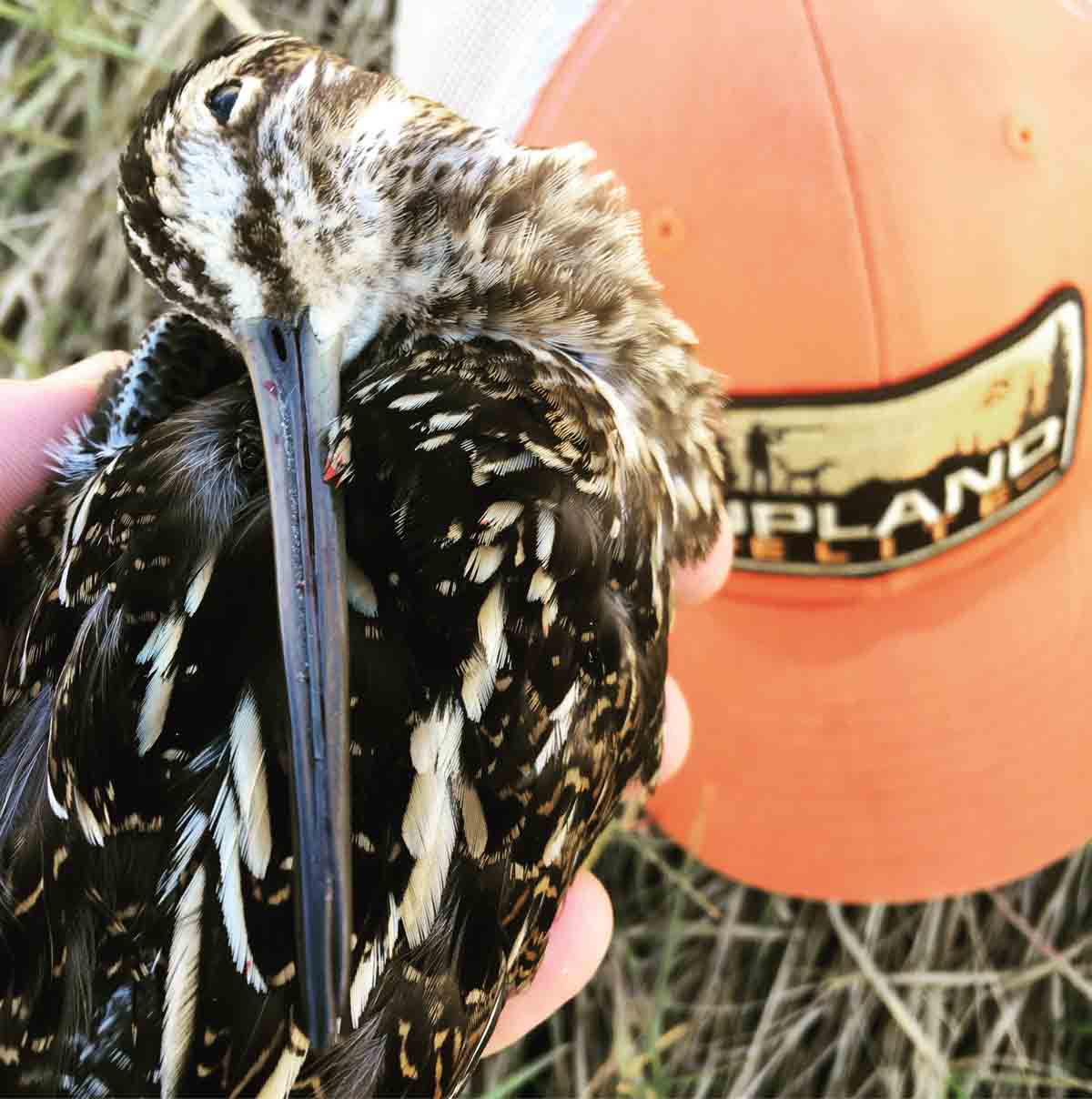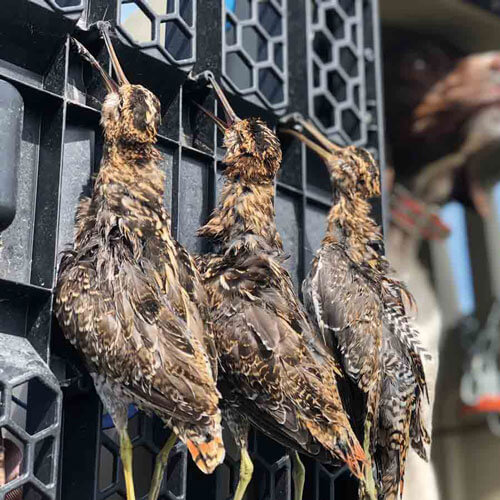A Hat Trick of Snipe
Scott Lindars
For most upland bird hunters, autumn ushers in long-awaited days afield in young aspen coverts, thick rows of CRP fields, or perhaps stately pine plantations. Down here in the southern reaches of Florida, we dream of mud, marshes, and the occasional cow pie.
I pursue neither the noble grouse nor the beloved bobwhite quail–not even the majestic ring-necked pheasant. No, my upland bird of choice is better known as the object of a childhood prank.
I am a snipe hunter.
Often overlooked by hunters, the Wilson’s snipe (Gallinago delicata) is a quirky little migratory game bird about the size of a dove that is guaranteed to test your dedication, nerves, and ability to hit the broad side of a barn. Emitting an unmistakable call, snipe erupt with blazing speed from their cover into erratic flight.
My introduction to snipe was born of necessity: I was eager to get my Brittany puppy started doing what he was meant to do–locate, point, and retrieve birds. But where was a relatively new upland hunter going to do that in South Florida? Bobwhite quail are the dominant game bird down here, but joining a hunt club or relying on guided hunts wasn’t my style–or amenable to my wallet. A few clicks through the snipe-hunting regulations–long seasons, generous bag limits, and a seemingly endless amount of habitat on public lands–and bingo: I knew I’d found my bird.
Armed with a sprinkle of a friend’s local knowledge and a simple gear kit consisting of rubber boots and a 12-gauge, I headed into the field. Much to my dismay, however, the cover I had planned to hunt was dry as a bone, and what little sign of snipe I found was far from fresh. I pushed on to a back-up spot I had picked out on Google Earth, and under the waning afternoon sun, I flushed my first snipe. Predictably, I scattered shot across the horizon as the snipe stayed ahead of the game. As luck would have it, he landed downrange as they often do, presenting me with a redemption shot. Flush, mount, swing, bang, drop: from that moment on, I was a snipe hunter.
Opening-Week Traditions
Like most close-knit groups of hunters, my crew has forged our own opening-day traditions. Opening days is a more appropriate term in my circle. Snipe migrate from the northern reaches of the United States and Canada, arriving after the blue-winged teal sometime in late October and throughout the fall. With a diet of worms and insects, soft, moist ground to forage and ample cover from predators are a must. Unlike tracking waterfowl, which key in on habitat at a more macro level and can be scouted from a distance, locating snipe is up-close and personal work. Find the right water levels, soil conditions, and timing of the migration, and you just might be in luck.
For the last few years, our season has begun at the tailgate with my favorite father-and-son duo, Eddie and Matt. We start at a reliable, centrally located Wildlife Management Area that affords a variety of field conditions. With annual changes in grazing, mowing, fire, and water levels, what was a hot piece of cover in one season may turn up goose eggs the next.
Some years it’s a snipe bonanza, with unpressured birds flushing underfoot and putting up great numbers. Other years, we push long and hard to move even a few birds. Either way, we’ll return with a fistful of spent shells, birds in the bag, and a better sense of what to do next time. From there, I begin a traverse across Florida–a mini-road trip, laying down the miles as I survey as many pieces of cover as I can in the first few days.
South? West? North? That first day in the field suggests where to go next. Over the next few days, I hit a handful of my favorite spots, monitoring soil moisture levels, cover conditions, and of course bird counts. By the end of my Goldilocks-like loop, I settle into finding the “just right” regions, taking note of what is bound to improve, what will probably decline, and what may remain reliable.
Snipe in the Spread
After this season’s road trip, I believed that one of my favorite spots had gone bust. Conditions were dry as a bone and might as well have been flashing a “closed for business” sign to inbound snipe. Matt and I hit every piece of previously reliable cover, and then we took a chance in a little marsh that was new ground to me. To our elated surprise and relief, we finally found muddy ground. Not even 100 yards in, we started moving birds. We fanned out and worked the cover, emptying our barrels and filling our game bags.
I knew instantly that this spot would be on the repeat-visit list for snipe–but what really caught my eye were the ducks. First, a pair of mottled ducks persistently circled overhead, looking for a place to land. Despite us standing tall, draped in blaze orange, these birds wanted in; apparently the shallow water and hydrilla were just too good to pass up. Soon after, a pod of five blue wings bombed into the other side of the marsh.
When the first split of waterfowl season arrived, I returned an hour before first light, trading my 20-gauge side-by-side for my 12-gauge duck gun. My plan was to sit for ducks at sunrise and then shift gears to snipe. Walking in under the cover of darkness, I could hear snipe flushing in every direction. They were still there!
Remi the Brittany by my side, we backed into some shrubs and palmettos along the water’s edge, fashioning a makeshift blind. I tossed out two mottled decoys and a handful of teal and settled in to watch the chorus of birds come to life as the sun climbed over the horizon. The killdeer warmed up first, followed by herons, and then flight after flight of ibis. But no ducks.
Was this their roost? Was this spot only an evening feed? As I questioned the wisdom of my 6 a.m. boondoggle, the occasional blast of a shotgun in the distance kept me focused and motivated. Then something most unexpected began.
As the marsh warmed up with the morning sun, the snipe began to fly. Like an incoming fighter jet, a snipe tore across the marsh, landing on the water’s edge utterly unaware of my presence. I watched him methodically probe the soft ground with his long, delicate bill. Swapping my gun for my camera, I rolled video of this rare, up-close experience with a snipe.
 I soon realized this wasn’t a one-off: I had set up in a prime breakfast spot. Another flight of snipe came in, and for the first time I was shooting snipe on the inbound wing, not the flush. Over the next hour, I took another four as they cupped their wings in for a landing. Remi went to work on the retrieves, but the truth is that this was the rare instance when a bird dog was completely unnecessary: No downed birds were buried deep in high grass; these birds were falling clear as day in the decoys and on the shoreline.
I soon realized this wasn’t a one-off: I had set up in a prime breakfast spot. Another flight of snipe came in, and for the first time I was shooting snipe on the inbound wing, not the flush. Over the next hour, I took another four as they cupped their wings in for a landing. Remi went to work on the retrieves, but the truth is that this was the rare instance when a bird dog was completely unnecessary: No downed birds were buried deep in high grass; these birds were falling clear as day in the decoys and on the shoreline.
The birds had now settled in across the marsh, and my back screamed for relief from crouching down in the blind. Remi and I worked our way down the marsh’s edge and in no time had our daily bag limit of eight birds. As I walked back to the truck, I daydreamed of returning with snipe decoys to take this accidental tactic to a new level. I have a pile a dove decoys in my shed that are just begging to be transformed into snipe this summer.
The Orange Honey Hole
In Florida, we have the luxury of a long snipe season that runs from November 1 to the middle of February. As the season wears on, the hunt naturally becomes more difficult. Birds learn, and the obvious spots are worked over, leaving us to seek out fresh ground. Matt and I save a special piece of private land for late season. Once a thriving orange orchard, the land has since been cleared of trees.
What remains are acres of raised ground–the neat rows, as perfect as corduroy wales, that once held orange trees. Atop the rows and providing plenty of concealment are ankle- to knee-high tufts of grass. In the troughs between the rows is standing water left over from the fall rains. And on the edges of the rows are soft, fresh feeding grounds, continually recharged as the water drops. In other words, what remains is ideal snipe habitat.
 Our tactic in this snipe mecca is to systematically work the rows, each shooter taking a side, working from one end to the other. Snipe that give us the slip or flush early don’t go far; with no pressure from other hunters, they are content to land a few rows over and resume feeding. Having hunted this spot multiple times, Remi is hip to the game, working the adjacent rows while we push ground underfoot.
Our tactic in this snipe mecca is to systematically work the rows, each shooter taking a side, working from one end to the other. Snipe that give us the slip or flush early don’t go far; with no pressure from other hunters, they are content to land a few rows over and resume feeding. Having hunted this spot multiple times, Remi is hip to the game, working the adjacent rows while we push ground underfoot.
Having made it to the end of the farm and back, our game straps had a few empty spots begging to be filled. Adjacent to the orange rows is an abandoned cattle pen and pond; we always save this spot for last, reserving it as a refuge throughout the day. Once we entered, the snipe erupted in a hurry–singles, doubles, and even triples flushed all around us. We fired a shot, and snipe more flushed. Gone for a retrieve, Remi flushed two more. We actually faced too many birds. Talk about first world problems.
As the chaos settled, I cautiously crept forward, keeping Remi on a close heel. Scrape–the unmistakable call of a flushing snipe drew my eyes to the pond. Fast and to the left, the bird attempted to outrun my #8 shot, falling like a stone in the middle of the pond. Now, Brittanys are not normally considered water dogs–nevertheless, Remi charged into the water without hesitation. To my delight, he completed his first deepwater retrieve like a seasoned pro. Smiling as wide as the horizon, I heaped praise on him as he returned the bird to hand.
We ended the day on an impossibly high note, Matt and I indulging in a celebratory beer back at the truck. Upon reflection, yes, it was a challenging season. Yes, we faced many unique and unpredictable experiences. But those experiences were shared with close friends–and favorite dogs. And that is why I can say with confidence, keep your brand-name birds.
I am a snipe hunter.
Scott Lindars (@marshdoodle) is the founder of Marshdoodle.com, the first lifestyle brand and social community dedicated to the passion and pursuit of hunting Snipe. Marshdoodle was born to give Snipe hunters their own rallying cry and celebrate a premier, but lesser known upland game bird.
Scott hunts upland birds and waterfowl over a Brittany and trains with the NAVHDA Palmetto Chapter. His family lives in South Florida, with central access to Florida’s amazing public lands, the Everglades, Lake Okeechobee, and is surrounded by the salt life.



